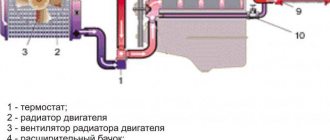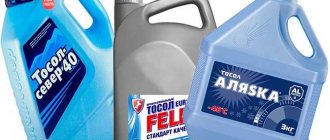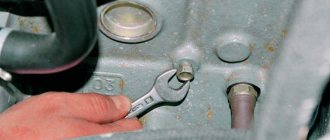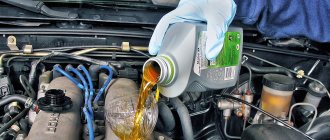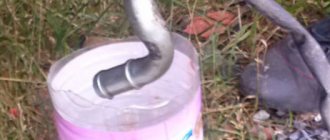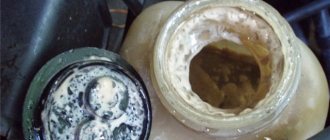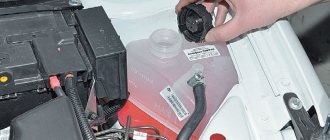How to change antifreeze on a Peugeot 308
The liquid cooling system of the Peugeot 308 is designed to remove heat from the engine. Circulation channels run near the cylinders and combustion chambers for maximum protection against overheating.
The antifreeze used in the cooling system effectively copes with this task, but over time its properties are lost. Therefore, the coolant must be changed periodically.
Changing the coolant of Peugeot 308
Typically, the coolant is replaced during routine maintenance. But in some cases, the fluid is changed before it reaches the end of its service life, for example, after a repair has been carried out that involves draining the antifreeze.
Replacement instructions are suitable for Peugeot models with an EP6 (EP3) engine:
Draining waste fluid
The Peugeot 308 does not have drain plugs, so the liquid must be drained by removing the pipes. To access them, you need to remove the original protection from below (Fig. 1).
It is secured with 8 bolts:
- 2 at the rear, turnkey for 16;
- on the sides 4, turnkey 10;
- in the front part, 2 turnkey for 13.
After gaining access, we proceed directly to the drain:
- place the drain container and unscrew the lower radiator hose (Fig. 2);
In this way, we drain the antifreeze from the Peugeot 308 as much as possible, but you need to understand that some of the liquid still remains in the cabin heater and some pipes.
Flushing the cooling system
If you think that your cooling system is heavily clogged with deposits, you can use specialized flushes. For these purposes, chemicals from any well-known manufacturer are suitable, for example, Hi Gear 7-minute wash.
If you plan to change the brand of antifreeze, then flushing with distilled water is suitable. For this procedure, a 20 liter canister is sufficient. It will be enough for 3-4 runs.
Filling with new antifreeze without air pockets
When the old fluid has been drained and the system is completely clean, you can begin to fill in new antifreeze. We check again the pipes that we should have put in place, and leave the air outlet holes open.
Let's start filling the system:
- pour antifreeze into the cooling tank to the maximum mark (Fig. 1);
Do-it-yourself filling and replacement is complete, but you need to remember that after the first day of operation you should check the fluid level in the tank.
see also
Comments 126
Relatives 122 thousand, this is a new car. With this 1.6 Peugeot petrol engine, my mileage is 325, I think it’s a bit old and needs to be changed. What kind of liquid was splashing there if there was garbage in the system? If you filled in normal antifreeze, it shouldn't.
Well, not garbage, but scum. Because this engine is “hot” + G11 antifreeze, then this is natural. Now G12+ has been uploaded.
How much does a new thermostat cost? Will it fit my Peugeot 2008 2014, 1.6, 120hp, manual transmission?
Turn on the stove, don’t turn it on, it makes no difference. All the same, antifreeze flows through the heater radiator in full flow. The instructions are for those who use a faucet to regulate the flow of liquid. This makes it even worse - the radiator is cooled by air and the flushing efficiency decreases.
Hello, tell me, are there any repair kits for the blue thermostat gasket? or will this not help?
Eat. It will help if there is a leak from under it.
Hello, tell me, are there any repair kits for the blue thermostat gasket? or will this not help?
Article 1340 88
Tell me, is 7 liters enough? Or, on the contrary, is there too much left?
5l was enough. In total, approximately 6.5 liters enter the empty system.
Thanks for the report)) I changed the thermostat. mileage 155 thousand. judging by the temperature, it was not clear that the thermos had died until the hose from the thermos to the stove was torn off)). I'm sick of it, that's putting it mildly))))) only I also filled the chip of the first oxygen sensor with antifreeze)) then I dried it and blew it out for a long time, otherwise the speed fluctuated terribly))) take care of it when replacing the thermos) and by the way, I dropped the bracket)) look it’s either on the starter or on the corrugation)) I didn’t bother much with antifreeze, I filled it with Felix red G12, before that it was the same one, the original one blew up the entire radiator of the stove.
Good afternoon. Thank you for the complete report on the work done. Question: Is this the first replacement in 5 years and 120 thousand kilometers?
Hello. Thanks for the answer. I am planning to replace the coolant, the mileage is 76,000 km, the question arose whether to rinse with additional additives or to rinse with distillate is enough... the annoying nuance is that after exposure to an aggressive environment on deposits, these very deposits will clog the small honeycombs of the stove radiator...
They won't score. If there is already silt there, then sooner or later it will make itself felt, then remove it and boil it in lemon juice.
Thanks for the answer...we'll act)
nevermind. and my mileage is 93,000.
Guys, I just bought a car, I’m still new to this business, can anyone tell me what’s the matter? In general, the car began to boil. I touched the pipes - the bottom one is cold. The thermostat started to fail. I ordered a new one, it has already arrived from BMW. I decided to go out and start it. I started it up and noticed that there were plugs in the cooling system, and large ones at that. I got scared. I thought my head was leaking, but traffic jams don’t depend on whether you’re accelerating or not. And there is no white smoke. Moreover, they come out exactly when you open the lid of the barrel. I'm already scratching my head about where the traffic jams came from. And what could it be? antifreeze does not go away. It only starts to go away when you start the car. Well, bubbles appear and along with it the antifreeze fails. This is such bullshit. What to do? How to air it out? And in general, is it worth changing the thermostat? In addition to this, the car started up yesterday, then stalled, but at the same time the fan began to work O_O And the car was cold. Could it be that the thermostat is acting up like that?
Replacement frequency, what antifreeze to fill
The original antifreeze poured into the Peugeot 308 has a blue-green color and a G11 approval; PSA Longlife produces it under its own label. But in fact, this is the usual GLYSANTIN G33, which is produced by BASF. PSA Longlife markings for antifreeze are 9735.K1, 9735.K0, and for concentrate 9735.K4.
Based on the experience of motorists who own this brand, it is advisable to do a complete wash when replacing. Do not use the original antifreeze, but buy G12 or a higher class and switch to it.
Antifreeze volume table
| Model | Year of issue | Engine capacity | how many liters of antifreeze are in the system | Original/recommended fluid |
| Peugeot 308 | 2007 | 1.4 | 6.0 | PSA Longlife / 9735.K1, 9735.K0, 9735.K4 GLYSANTIN G33 REVKOGEL 2000 |
| 2007-2013 | 1.6 | 6.2 | ||
| 2007-2013 | 2.0 | 6.0 | ||
| Peugeot 208 | 2007-2013 | 1.6 | 6.2 |
Antifreeze for Peugeot 308 T7
The table shows the type and color of the required antifreeze for filling into the Peugeot 308 T7, produced from 2012 to 2014. Print
| Year | Engine | Type | Color | Lifetime | Recommended Manufacturers |
| 2012 | for all | G12++ | red | from 5 to 7 years | Freecor QR, Freecor DSC, Glysantin G 40, FEBI |
| 2013 | for all | G12++ | red | from 5 to 7 years | FEBI, VAG, Castrol Radicool Si OAT |
| 2014 | for all | G12++ | red | from 5 to 7 years | Frostschutzmittel A, FEBI, VAG |
For diesel and gasoline engines the parameters will be the same! When purchasing, you need to know the shade - the Color and Type of antifreeze allowed for the year of manufacture of your 308 T7. Select the manufacturer at your discretion. Do not forget - each type of liquid has its own service life. For example, for a Peugeot 308 (T7 body) 2012, with any type of engine, a lobrid antifreeze class, type G12++ with shades of red, is suitable. The approximate period of the next replacement will be 7 years. If possible, check the selected fluid against the vehicle manufacturer's specifications and service intervals. Important to know Each type of liquid has its own color. There are rare cases when the type is tinted with a different color. The color of red antifreeze can be from purple to light pink (green and yellow have the same principles). It is possible to mix liquids from different manufacturers if their types meet the mixing conditions.
- G11 can be mixed with G11 analogues
- G11 cannot be mixed with G12
- G11 can be mixed G12+
- G11 can be mixed G12++
- G11 can be mixed G13
- G12 can be mixed with G12 analogues
- G12 cannot be mixed with G11
- G12 can be mixed with G12+
- G12 cannot be mixed with G12++
- G12 cannot be mixed with G13
- G12+, G12++ and G13 can be mixed with each other
- Mixing antifreeze with antifreeze (traditional class coolant, type TL) is not allowed. No way!
- Before completely changing the type, rinse the radiator with plain water
- At the end of its service life, the liquid becomes discolored or becomes very dull.
- Antifreeze and antifreeze - very different in quality
- Antifreeze is the trade name for the traditional type (TL) of old-style coolantAdditionally
Colors? (Elena)
Good day, Elena. We have always said and will continue to tell our users that the color of the coolant does not matter. Color does not in any way affect the composition and additives added to antifreeze. When purchasing this consumable, you should never be guided by color, since even the original coolant can be a fake with absolutely any shade.
Leaks and problems
The main reasons associated with antifreeze leakage lie in ignorance of certain details. In the Peugeot 308, such a small thing is the coolant reservoir cap. It has two valves, inlet and outlet, to maintain an optimal system pressure of 1.4 bar.
To avoid jamming, the valves must be periodically washed, and the plug itself must be changed every 2 years. When the valve jams, the pressure in the system increases and, as a result, antifreeze leaks in a weaker place.
Leaks in the Peugeot 308 cooling system, if they do occur, in most cases are not difficult to determine the location. As usual, this could be leaky pipes or a water pump, from which the leak will be noticeable on the timing belt guard.
Liquid may also leak from the thermostat, but this problem may not be immediately detected, since this place is covered by the installed air filter housing.
Coolant
- Log in to reply to this topic
#21
- Users
- 24 messages
- No name
- City My city is not in the list
- The car is not Peugeot
#22
- Name Alexander
- Samara city
- Peugeot 308 car
#23
- Name Victor
- Rostov-on-Don
- Car Peugeot 207 5d
- More details Audi A6 (C7) 180 lc TFSI (white metallic) 2013
- Dreams of an Audi Q-5
#24
- City of Saint Petersburg
- Peugeot 308 car
#25
Let's live in such a way that even the undertaker mourns our death.
- Name Alexey
- City My city is not in the list
- Peugeot 308 car
- More details 120hp EP6 1.6V
- Dreams of a Peugeot Hoggar
Hello. Please tell me if anyone has encountered this issue. What kind of coolant does our 308 use? I looked and all my neighbors in the parking lot had either blue, or blue-green, or red. For some reason, mine is transparent yellow-orange with the smell of alcohol and non-oily. in our Nizhny Novgorod showroom they say that this is how it should be, that it comes from the factory like this. They sell something for around 350 rubles for 2 liters called “Peugeot coolant”, but they say that it is already blue-green in color (no need to dilute it), and that you can mix the factory version and the one on sale, Nothing will happen. The instruction manual only states that you should use the one recommended by the manufacturer. who gets out of the situation? What coolants does anyone use? Thank you!
#26
- Name istopnik
- City of Kirovsk (Murm.)
- Peugeot 308 car
- More details Peugeot 308 1.61 VTi 120hp with 5-speed manual transmission Release 2011
Citroen/Peugeot 9735.K0 Antifreeze “PSA Longlife”, 5l (except 4007, C-Crosser,107) Citroen/Peugeot 9735.K1 Antifreeze “PSA Longlife”, 2l Citroen/Peugeot 9735.K5 Antifreeze “PSA Longlife”, 1l ( except 4007, C-Crosser,107)
my color is blue-green
Post edited by istopnikS: December 14, 2020 – 21:19
#27
- Name Lesha
- City My city is not in the list
- Peugeot 505 car
It’s even written in my manual to use G12 class antifreeze. It is light red in color. I am partly organic. I talked with the owners of 307, 3008 is recommended not to change. Pouring it. There is no difference in price. But the owner of 307, 3008, after using G10 (it’s green or blue), the rubber bands on the evaporator began to leak after a while. It's completely synthetic in my opinion.
And which side does the evaporator come into contact with antifreeze?
#28
Details about my car - https://www.drive2.ru/r/peugeot/1708432/
- Name Dmitry
- Kursk city
- Peugeot 407 car
- More details Peugeot 2.0Hdi RHR 2004
- Dreams of a BMW Alpine
I once wondered - I was looking for this PSA antifreeze, but in our muhosransk there is no such thing, it costs quite inhumane to order, like that, I spat and filled it with Felix G12. I probably skated 70-80 thousand on it, changed it once. In the summer, for unknown reasons, a plastic pipe flew out of the thermostat, and I stayed with my comrades at the agricultural base. they had the same yellow G12 Felix antifreeze. I changed it on the spot and left. Periodically disassembling the car, changing the thermostat, etc., I did not notice any scale, nor any sinks. The temperature is the same. On Lancer 9, there was a problem once on the road - I had to mix G11 and G12 - I didn’t notice any foaming, boiling, or deposits. HZ, maybe I was just lucky, or maybe it’s all just bullshit. I try to replace antifreeze every 30-40 thousand, or always after work such as changing the thermostat or radiator) Such are the things
Video “Changing consumables with your own hands”
To learn how to change fluid at home, watch the video using the example of a Citroen C4 (by Oleg Zuyeff).
I don’t know what the PSA concern was guided by when it poured this gruel into brand new cars at the factory, but clearly not with the best intentions.
In this post I will tell you why I came to this conclusion.
photo of spikral from Goruks
. He also has good instructions for flushing the cooling system. Instructions for flushing the cooling system. Instructions for removing and washing the heater radiator. They will be useful to us later.
First a little theory
Currently, antifreezes (coolants) based on the composition of anti-corrosion additives are divided into lobrid, carboxylate, hybrid and traditional types. According to the Volkswagen classification, the division is as follows: G11, G12, G12+, G12++, G13
1) Traditional/antifreeze.
Base
: Ethylene glycol.
Additives
: based on silicates, borates, nitrides, phosphates and amines (at the same time).
Colour
: usually blue.
Action
: Covers the entire cooling system with a protective film of silicates.
Over time, the film grows quite large, which impairs heat transfer and reduces engine cooling efficiency. When heated to 108 degrees, additives may precipitate. Life span
is from 0.5 to 2 years.
If the liquid turns yellow after six months, this is a sure sign of corrosion. Compatible
with G11.
2) G11- Hybrid/or VW TL 774-D(G11), Traditional Coolant, Conventional Coolants, IAT (Inorganic Acid Technology)
.
Base
: Ethylene glycol.
Additives
: Contains inorganic silicate additives: silicates, phosphates, borates, nitrites, amines, nitrates.
Color
: Available in blue, green or blue-green.
Action
: similar to antifreeze.
The lifespan
has a slightly improved formula than antifreeze, so the lifespan of such antifreeze is up to 2 years.
Compatible
: with antifreeze.
3) G12 -Carboxylate/or VW TL 774-D(G12), Carboxilate Coolant, OAT (Organic Acid Technology)
.
Base
: Ethylene glycol.
Additives
: Based on organic carboxylic acids.
Color
: red.
Action
: The protective anti-corrosion film has a very small thickness and is formed only where there is a source of corrosion.
Life span
: up to 3-5 years.
Compatible
: with G12+/ G12++. Do not mix G11 and G12 under any circumstances.
Read more: Audi car disassembly in Ryazan
4) G12+ - Carboxylate/or VW TL 774-F(G12+)? Hybride Coolant, HOAT (Hybride Organic Acid Technology)
(We combined carboxylate technology with silicate technology).
Base
: Ethylene glycol.
Additives
: Based on organic carboxylic acids and inorganic ones.
Color
: Purple.
Action
The operating principle is similar to G12.
Lifespan
: up to 5 years.
Compatible
with G12/G11/antifreeze.
5) G12++ - Carboxylate/or VW TL 774-G(G12++), VW TL 774-H(G12+++), Lobride Coolant, SOAT Coolants
.
Base
: Ethylene glycol.
Additives
: based on organic acids with a minimum amount of mineral additives using Lobrid technology.
Color
: Purple.
Operation
The operating principle is similar to G12/G12+.
Lifetime
: The boiling point is increased to 135°C, and at the same time all additives retain their properties.
Lifespan
: up to 5 years.
Compatible
with G12+/G12/G11/antifreeze.
6)Lobrid/G13.
.
Base
: unlike its predecessors, instead of a toxic ethylene glycol base, it has a harmless and “environmentally friendly” glycerin or propylene glycol base.
Color
: lilac.
Operation
The operating principle is similar to G12/G12+/G12++.
Lifespan
: up to 10 years.
Compatible
with G12+/G12/G11/antifreeze
To consolidate the theory, you can watch a very good video on YouTube Classification of antifreeze - - - - - - - - - - - - - - - - - - - - - - - - - - - - - - - - - - -
EDITED an hour after publication. Friends, thank you for putting me on the right path.
This link helped me with this, as well as this one and this one.
The original PSA Longlife antifreeze is a hybrid antifreeze i.e. according to WV classification - G11.
- this is GLYSANTIN G33 concentrate from BASF
diluted with distilled water and packed in canisters PSA Longlife 9735 K0-5 liters, 9735 K1-2 liters, 9735 K5-1 liters. According to the WV classification, this antifreeze has a classification of G12. those. It's not as bad as I thought. )))
A well-known problem with the Peugeot 308 is a poorly heating stove.
Already in three-year-old cars, users note that the heater does not heat properly and from year to year it heats worse and worse. Those who have washed radiators note that the radiator honeycombs are very narrow. The reason lies in the principle of antifreeze action. Let me remind you: Antifreeze covers the entire cooling system with a protective film of silicates. Over time, the film grows quite large, which impairs heat transfer and reduces engine cooling efficiency.
All the same, the reason for the poorly heating stove, in my opinion, is precisely the timing of the antifreeze change. G12 lives under ideal conditions for up to 5 years. But as has been noted more than once, Russia is recognized as a country with difficult conditions. Therefore, it’s strange that the oil change schedule was reduced by 2 times (which is still not sufficient. Read more about choosing oil for EP6
in the previous entry), but the service life of the antifreeze was not reduced.
Moreover, PSA recommends a period for changing antifreeze - 6 years (or 120,000 km)!
Naturally, after this the stove will not heat up! By this time, it’s not even possible to determine the color of the expansion tank. Antifreeze had lost all its properties by this time, and for the last 3 years it not only did not protect, but contributed to corrosion processes. This is evidenced by the reddish tint of 5-6 year old antifreeze.
Read more: Diameter of the brake cylinder VAZ 2108
We can talk about the topic of what PSA people are bad people for quite a long time. but it won't change anything. And we need to think about our cars. What to do? Of course, change the antifreeze!
Taking this opportunity, you can upgrade to a higher class of antifreeze. I couldn’t find any information about G13, how good they really are. Usually, when they do something for the sake of the environment, they cut back on some useful properties. Therefore, I would focus on G12++ carboxylate antifreezes. In addition, their use will result in less scale formation. Let me remind you that G12++ has an increased boiling point to 135°C, and at the same time all additives retain their properties.
Before changing antifreeze
Be sure to flush the entire cooling system.
And not only with water, but also with chemistry (For example: Liqui Moly “Kuhlerreiniger”
). If the shift deadlines are not met, the additives are likely to precipitate. The reason for the need to use chemicals lies not only in the fact that it is necessary to wash off the scale that has formed in the cooling system, but is also related to the principle of operation of hybrid antifreezes. G11 covers the entire cooling system with a protective film and now needs to be removed to unlock the full potential of more modern antifreeze. In addition, manufacturers do not recommend mixing antifreeze of different brands, guided by the fact that it is not known how the additives will react to each other. Although in the conditions for using antifreeze they write that they can be mixed, but with the caveat “only in emergency cases.” Then it is recommended to change this batch at the first opportunity. It is also worth adding the fact that when different classes of antifreeze are mixed, the service life of this mixture is equal to the service life of the lowest class antifreeze.
As luck would have it, I recently changed the antifreeze completely, but without understanding the topic, I trusted the car service specialists and, without even offering me options, they filled me with G11 =(. after all, G12 (it’s not as bad as it turned out)
But still, to sum it up...
The original antifreeze is crap, it lasts no more than 2 years.
The recommended change intervals are not suitable for this antifreeze. As a result, deposits and clogged small honeycombs of the stove radiator. As a result, the stove does not heat. As a living example of my words, here is a link to an entry in which, after 4 years of using the original antifreeze, I had to flush the stove.
I think I’ll wait until the summer and, as I wanted, I’ll flush the cooling system and change the antifreeze to G12++. As a law-abiding citizen, I waited 6 years before changing the antifreeze, as required by the instructions, but at the end of last winter I noticed that the stove was heating less well.
* I will try to continue to please all subscribers with interesting posts.
__________________________________________________________________________
Thank you for your attention!
If this post was useful to you, don’t be lazy to click on the buttons
How to change antifreeze on a Peugeot 308
The liquid cooling system of the Peugeot 308 is designed to remove heat from the engine. Circulation channels run near the cylinders and combustion chambers for maximum protection against overheating.
The antifreeze used in the cooling system effectively copes with this task, but over time its properties are lost. Therefore, the coolant must be changed periodically.
Changing the coolant of Peugeot 308
Typically, the coolant is replaced during routine maintenance. But in some cases, the fluid is changed before it reaches the end of its service life, for example, after a repair has been carried out that involves draining the antifreeze.
Replacement instructions are suitable for Peugeot models with an EP6 (EP3) engine:
Draining waste fluid
The Peugeot 308 does not have drain plugs, so the liquid must be drained by removing the pipes. To access them, you need to remove the original protection from below (Fig. 1).
It is secured with 8 bolts:
- 2 at the rear, turnkey for 16;
- on the sides 4, turnkey 10;
- in the front part, 2 turnkey for 13.
After gaining access, we proceed directly to the drain:
- place the drain container and unscrew the lower radiator hose (Fig. 2);
In this way, we drain the antifreeze from the Peugeot 308 as much as possible, but you need to understand that some of the liquid still remains in the cabin heater and some pipes.
Flushing the cooling system
If you think that your cooling system is heavily clogged with deposits, you can use specialized flushes. For these purposes, chemicals from any well-known manufacturer are suitable, for example, Hi Gear 7-minute wash.
If you plan to change the brand of antifreeze, then flushing with distilled water is suitable. For this procedure, a 20 liter canister is sufficient. It will be enough for 3-4 runs.
Filling with new antifreeze without air pockets
When the old fluid has been drained and the system is completely clean, you can begin to fill in new antifreeze. We check again the pipes that we should have put in place, and leave the air outlet holes open.
Let's start filling the system:
- pour antifreeze into the cooling tank to the maximum mark (Fig. 1);
Do-it-yourself filling and replacement is complete, but you need to remember that after the first day of operation you should check the fluid level in the tank.
What kind of coolant should I pour into the Peugeot 308?
If you have this question, then first of all you should refer to the service book of your vehicle. In it, the manufacturer clearly indicates which consumables (antifreeze and oil) can be poured into the car. Green antifreeze, as you wrote, can also be ordinary domestic “Antifreeze”, which is better not to fill in Peugeout, except in the most extreme cases.
Original refrigerant "PRO"
Specifically, in the case of model 308, the manufacturer recommends using a refrigerant that belongs to the G12 standard. This classification applies to many manufacturers and is given only if the product is suitable for use in a particular car. Products of class G12 can be of any color - red, green, yellow, and blue. But (!) not every green, red, yellow or blue antifreeze meets this standard. The best option would be to use the original product called “PRO”, designed specifically for Peugeout and Citroen. But finding this coolant in stores can be problematic.
Read more: Door cards for Ford Focus 2
When you go to the store to buy refrigerant, ask the seller about the coolant that corresponds to this classification or read the label on the package yourself - this information will be there in any case.
As for the manufacturers themselves, coolants currently use the following refrigerants:
The choice is made only by you, depending on your preferences and capabilities. The cooling system of this car will require at least 6.2 liters of liquid. Replacing coolant involves not only draining and filling the material, but also flushing the cooling system, radiator and engine. You can learn more about this process by following the link - everything is described in detail here. We hope this information will be useful to you.
Replacement frequency, what antifreeze to fill
The original antifreeze poured into the Peugeot 308 has a blue-green color and a G11 approval; PSA Longlife produces it under its own label. But in fact, this is the usual GLYSANTIN G33, which is produced by BASF. PSA Longlife markings for antifreeze are 9735.K1, 9735.K0, and for concentrate 9735.K4.
Based on the experience of motorists who own this brand, it is advisable to do a complete wash when replacing. Do not use the original antifreeze, but buy G12 or a higher class and switch to it.
Antifreeze volume table
| Model | Year of issue | Engine capacity | how many liters of antifreeze are in the system | Original/recommended fluid |
| Peugeot 308 | 2007 | 1.4 | 6.0 | PSA Longlife / 9735.K1, 9735.K0, 9735.K4 GLYSANTIN G33 REVKOGEL 2000 |
| 2007-2013 | 1.6 | 6.2 | ||
| 2007-2013 | 2.0 | 6.0 | ||
| Peugeot 208 | 2007-2013 | 1.6 | 6.2 |
Antifreeze for Peugeot 308 T9
| The table shows the type and color of the required antifreeze for filling into the Peugeot 308 T9, produced from 2013 to 2020. | |
| Year | Engine | Type | Color | Lifetime | Recommended Manufacturers |
| 2013 | petrol, diesel | G12++ | red | from 5 to 7 years | FEBI, VAG, Castrol Radicool Si OAT |
| 2014 | petrol, diesel | G12++ | red | from 5 to 7 years | Frostschutzmittel A, FEBI, VAG |
| 2015 | petrol, diesel | G12++ | red | from 5 to 7 years | MOTUL, VAG, Castrol Radicool Si OAT, |
| 2016 | petrol, diesel | G12++ | red | from 5 to 7 years | Freecor QR, Freecor DSC, FEBI, Zerex G |
The data in the table is close to those recommended by Peugeot When purchasing, you need to know the shade - Color and Type of antifreeze allowed for the year of manufacture of your 308 T9. Select the manufacturer at your discretion. Do not forget - each type of liquid has its own service life.
For example: for a Peugeot 308 (T9 body) 2013, with a gasoline or diesel engine, a lobrid antifreeze class, type G12++ with shades of red, is suitable. The approximate time for the next replacement will be 7 years. If possible, check the selected fluid for compliance with the requirements of the vehicle manufacturer's specifications and maintenance intervals. Important to know Each type of liquid has its own color. There are rare cases when the type is tinted with a different color.
The color of red antifreeze can be from purple to light pink (green and yellow have the same principles).
Mixing liquids from different manufacturers is possible if their types meet the mixing conditions. • G11 can be mixed with G11 analogues • G11 cannot be mixed with G12 • G11 can be mixed with G12+ • G11 can be mixed with G12++ • G11 can be mixed with G13 • G12 can be mixed with G12 analogues • G12 cannot be mixed with G11 • G12 can be mixed with G12+ • G12 cannot be mixed mixed with G12++ • G12 cannot be mixed with G13 • G12+, G12++ and G13 can be mixed with each other • Mixing Antifreeze with Antifreeze is not allowed. No way! Antifreeze and Antifreeze differ greatly in quality. Antifreeze is the trade name for the traditional type (TL) of old-style coolant. At the end of its service life, the liquid becomes completely discolored or becomes very dull. Before replacing one type of fluid with another, rinse the car radiator with plain water. Full instructions. Additionally
| • Diagnostics of the condition of the filled antifreeze • How to correctly change the fluid in the system • Rules for mixing different antifreezes • Interpretation of the columns of the antifreeze selection table • Antifreeze for other Peugeot models • | Save useful pages! |
Leaks and problems
The main reasons associated with antifreeze leakage lie in ignorance of certain details. In the Peugeot 308, such a small thing is the coolant reservoir cap. It has two valves, inlet and outlet, to maintain an optimal system pressure of 1.4 bar.
To avoid jamming, the valves must be periodically washed, and the plug itself must be changed every 2 years. When the valve jams, the pressure in the system increases and, as a result, antifreeze leaks in a weaker place.
Leaks in the Peugeot 308 cooling system, if they do occur, in most cases are not difficult to determine the location. As usual, this could be leaky pipes or a water pump, from which the leak will be noticeable on the timing belt guard.
Liquid may also leak from the thermostat, but this problem may not be immediately detected, since this place is covered by the installed air filter housing.
labavto.com
With the onset of spring, it is advisable to check the condition of the antifreeze. If necessary, you need to replace it. In summer, the operating conditions of the cooling system are very different from winter. At high temperatures, it is necessary to constantly remove heat from the engine. Ineffective cooling system operation can lead to overheating and costly repairs. The procedure for replacing antifreeze is simple and can be done at home. You just need to buy coolant and replace it according to step-by-step instructions.
Selection of coolant and timing of its replacement
For the cooling system to function effectively, you need to fill in high-quality coolant (coolant). Some drivers try to replace it with ordinary water, but this should not be done, as it freezes in severe frost and will rupture the radiator and pipes. The operating temperature of the engine reaches 90 degrees, water boils at a temperature of 100 degrees. Therefore, boiling is inevitable, which can lead to serious consequences and scale formation.
Antifreeze or antifreeze is poured into the cooling system - a process fluid that is designed to cool the power unit during operation. In addition, they cover the cooling system elements with a protective film to prevent corrosion processes.
Antifreeze is a mixture of ethylene glycol with water and additives. The following types of antifreeze exist:
- Hybrid. They can be filled in after antifreeze. The service life of these antifreezes is two years. They are inexpensive, but are more suitable for older engines.
- Carboxylate. More advanced antifreezes G-12, G-12+ with additives based on carboxylic acids. It is a red liquid that crystallizes at -40 degrees and boils at 108 degrees. The peculiarity of this coolant is that it forms a protective layer only in areas of corrosion. Service life is three years. Antifreezes G-11 and G-12 should not be mixed. You can add any coolant to G-12+, but the service life will be reduced.
- Lobridaceae. G-12++ antifreezes have an unlimited service life if the rules of use are followed. These antifreezes are rarely found on sale and are expensive.
Antifreeze is a coolant with domestically produced inorganic additives. There are two types of it: blue antifreeze-40 and red antifreeze-65. It coats the cooling system elements with a layer of silicates. Over time, the protective layer increases. This is good protection against corrosion, but heat transfer becomes worse. When replacing the coolant, you need to thoroughly flush the entire system to remove silicates. The peculiarity of antifreeze is that it cannot be heated above 105 degrees, it does not boil, but the additives precipitate. Therefore, it is not suitable for modern engines that heat up to temperatures of 110 degrees.
The coolant on the Peugeot 308 should be changed when the service life of the antifreeze has expired or if there are signs that the antifreeze is not suitable for further use. The suitability of the coolant can be determined in the following ways:
- using a test strip;
- measuring the liquid with special instruments;
- by color: the coolant has acquired a rusty tint;
- by condition: presence of scale, metal shavings, foam.
Replacing antifreeze Peugeot 308
Peugeot 308. CHECKING THE LEVEL AND ADDING COOLANT
The manufacturer recommends using original coolant.
Do not mix liquids of different colors and different manufacturers. If you need to add coolant, but you do not know the brand of coolant in the system, replace all coolant in the cooling system. Use products only from trusted manufacturers. Remember that using low-quality coolant leads to expensive engine repairs! Before starting work, place the vehicle on a level surface.
Check the coolant level only when the engine is cold. Coolant is toxic, so take precautions when working with it.
Do not pour fluid into the reservoir above the “MAX” mark, as its volume will increase when the engine is running.
When starting the engine, the expansion tank and radiator caps must be closed.
Constantly monitor the coolant level. Its sharp decrease or increase should be a signal for an immediate check of the engine cooling system. If freshly poured antifreeze suddenly unexpectedly quickly changes color to brown, it means that you were sold a fake, in which they “forgot” to add corrosion inhibitors. Replace the fluid as quickly as possible before it has time to corrode the cooling system elements.
1. Check the coolant level. It should be between the “MAX” and “MI N” marks marked on the wall of the expansion tank.
2. To add fluid, unscrew the cap of the expansion tank.
. and add coolant to the “MAX” mark.
4. Close the expansion tank cap.
If the expansion tank is completely empty, press the filler cap of the radiator of the engine cooling system and turn it counterclockwise.
. and remove the plug
Add coolant to the edge of the filler neck. Then close the neck with a stopper.
Add coolant to the expansion tank to the required level (see above).
Screw the filler cap of the radiator of the engine cooling system tightly. When the engine is running, the cooling system is under pressure, so coolant may leak from under a loose plug or the plug may break off.
There are two valves installed in the radiator cap: intake A and exhaust B. The exhaust valve plays a big role in ensuring optimal engine temperature conditions. It maintains an excess pressure in the system of at least 0.08-0.10 MPa (0.8-1.0 kgf/cm2), ensuring an increase in the temperature at which the coolant begins to boil and preventing intense vaporization.
When the valve jams in the closed position due to overheating, a significant excess of excess pressure occurs - more than 0.2 MPa (2 kgf/cm 2), which can lead to damage to the radiator or failure of one of the hoses. In turn, jamming of the valve in the open position leads to premature boiling of the coolant.
Therefore, wash the radiator cap with running water once a year. If in doubt, replace the plug. Obviously, if you remove the radiator cap on an overheated engine and this action coincides with thermal shock, then boiling of the liquid and the formation of air pockets in the cooling system will be guaranteed.
